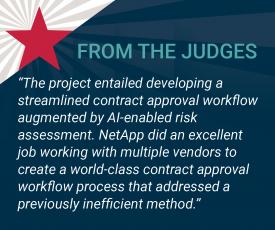A Value Champion in 2013, NetApp has been active in digital transformation for years. The Legal Department now can rely on a solid foundation of process evaluation, technology exploration, lessons learned, and established relationships as it continues to evolve an even more sophisticated approach to legal operations and finding solutions to manage low-risk, high-volume work. “If you are making phone calls or sending emails back and forth, that is a huge flag that the process presents an opportunity for digital transformation,” says Connie Brenton, Vice President, Law, Technology & Operations at NetApp.
In 2020, working with a team that included KP Labs, LexCheck, and QuisLex, NetApp tackled the problem of sponsorship agreements. Why so many partners?
“In a perfect world, we would have a single integrated platform in Legal, but no such thing exists in the industry at this point in time. To get a good end-to-end solution, you have to partner,” says Brenton.
The previous approach to the sponsorship agreements was highly inefficient. Although VP-level approval of procurement contracts is required if they deviate from standard positions, the approving VPs rarely had any knowledge of the underlying transactions. They would receive a contract summary and a description of deviating terms, but frequently had to consult senior in-house counsel for more information, often through lengthy email exchanges.
NetApp Legal Operations envisioned a new contract solution that uses artificial intelligence (AI) to put all necessary information at the VP’s fingertips: an overall risk rating, a risk report including mitigation measures, and a list of prior approvals and comments from Legal and other stakeholders. NetApp Legal Ops brought multiple providers and technologies together to create and implement an integrated solution to streamline the process, increase speed, and reduce overall risk.
NetApp Legal and QuisLex adapted the department’s existing contracts playbook to train LexCheck’s AI to analyze standard positions and acceptable alternatives. This analysis generates a risk report for each contract with recommended mitigation measures, and this information is provided to all business stakeholders simultaneously in an easy-to-read package.
KP Labs developed the workflow in TAP to integrate LexCheck and Adobe Sign, automatically routing the contract between all technologies and process constituents without the use of email. This enables a comprehensive audit trail and dashboard monitoring process throughput. The workflow enables a negotiated contract to be uploaded by Procurement, routed to LexCheck for assessment and risk reporting, and routed to preliminary approvers who address certain aspects, and then to final approvers who can execute with e-signature and automatically file in the contract repository.
The weighted scoring system considers the agreement type, the degree of variation between the pending position and the standard position, and availability of risk mitigation measures. The risk report is sent to preliminary approvers if a risk is identified within that person’s area of expertise—for example, Legal, Finance, Human Resources, Risk Management, and so on. Those approvers can approve, reject, or provide conditional approval if certain mitigation measures are taken, simultaneously. The final risk score and summary report is then routed to the VP for approval, along with a contact link for an attorney or procurement specialist in case assistance is needed. If the VP approves the agreement, it is then routed for e-signatures. If it is rejected, Procurement and Legal are notified.
“Working together with this team, we had the means to create the deviation report that puts all the information in front of the approver,” says Andy Banquer, Vice President for Corporate Solutions at QuisLex. “The real savings is time, but we also get good reporting on the things that deviate and the mitigation measures the business needs to take. A solution like this really can truncate cycle times, which satisfies internal clients.”
In fact, once implemented, the solution reduced approval time by 80 percent and reduced escalation rate from 80 percent to 10 percent.
The process was informed by NetApp’s previous forays into digitization. “There is always a set of ‘a-ha moments’ when working with AI: How long did it take it to get trained, how sophisticated does the resource need to be to train it, and how accurate is the outcome? Each time, there are lessons learned in every category,” says Brenton. Indeed, there are inherent lessons for in-house practice writ large, she says:
“This solution is about one agreement type, but in actuality—if we can get the industry to move to a more transformed way of working—it will fundamentally change how we work.”
Beth O’Callahan, General Counsel at NetApp, adds, “NetApp eagerly explores innovative ways to utilize AI in our own legal operations, especially since we provide industry-leading AI-driven data and cloud solutions to our customers around the world.”
